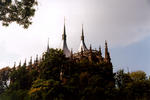|
 Průvodce Průvodce |
    St.Barbara Cathedral in Kutna hora St.Barbara Cathedral in Kutna hora
|
|
 Barborska ulice, Kutna Hora 284 00, Phone: 0327/512115
Barborska ulice, Kutna Hora 284 00, Phone: 0327/512115
St. Barbaras Cathedral built at the south-western edge of the town fortifications is a monumental building and co-creates towns historical panorama.
The Cathedral of the Holy Virgin Barbara was built in the late 14th and during the 15th to the first half of the 16th century. It originated in spite of the till then most influential authority controlling the development of the town - the Sedlec Cistercian monastery. It was an expression of the importance and power of the upper town, formed from the Seventies of the 13th century by mining communities which originated on the site of a rich finding-place of silver ore and in the early 14th century it became the economic centre of the Czech state and the place where its standard coin - the Prague groschen - was minted.
The cathedral symbolizes the self-esteem and exceptional ambitions and possibilities of the Kutna Hora patricians, who in view of their wealth enjoyed the favour of the Czech rulers.With their aid they gained royal privileges and the possibility of contact with the most developed manifestations of European art at the time for their town.The building of St.Vitus Cathedral at Prague Castle at the time of Charles IV. incited an endeavour of the patricians at Kolin and Kutna Hora to express their growing prestige by building a church of the cathedral type without the existence of a concrete ecclesiastic reason - Kolin and Kutna Hora were not the seat of a bishop at that time.
The first designer of the cathedral was evidently John Parler, son of Peter Parler, who built St. Vitus Cathedral in Prague. He designed the building as a church of the cathedral type with a gallery round the presbytery. Originally the cathedral was to have been of the triple-naved type and of greater length. In a very short space of time,however,it was changed into five-naved building of a length amounting to two thirds of its originally intented one. The Prague building workshop had been active at Kutna Hora already previously, having reconstructed the castle, later designated the Italian Court,in the early 14th century for the needs of a mint and a royal residence.In the Seventies of the 14th  century it commenced the building of a cemetery chapel with an ossuary at the foot of the rock promontory on which St. Barbaras Cathedral stands. The St. Barbara building workshop was situated on the site between the building and a quarry lying to the south-west of the cathedral from where special Kutna Hora sandstone, outstanding for preserved remainders of conches between the grains of sand,was obtained. In the course of its reconstruction in the late 19th century use was made of different fine-grained Horice sandstone for the changed and supplemented elements and this explains the difference which can clearly be seen between the original and the reconstructed parts of building. century it commenced the building of a cemetery chapel with an ossuary at the foot of the rock promontory on which St. Barbaras Cathedral stands. The St. Barbara building workshop was situated on the site between the building and a quarry lying to the south-west of the cathedral from where special Kutna Hora sandstone, outstanding for preserved remainders of conches between the grains of sand,was obtained. In the course of its reconstruction in the late 19th century use was made of different fine-grained Horice sandstone for the changed and supplemented elements and this explains the difference which can clearly be seen between the original and the reconstructed parts of building.
After Parler the St. Barbara workshop was headed in turn also by local masters,who proceeded in accordance with his project with only negligible changes. Another outstanding architect was Matyas Rejsek, who worked at Kutna Hora from 1489 until his death in 1506. Till 1512 work continued on the cathedral building after his design. The outer aisles and the gallery round the presbytery were provided with vaults and in 1499 the vaulting of the choir was also completed. Stonemason decorative elements typical of Matyas Rejseks projects appeared in architectural details.
The following head of the workshop - Benedikt Rejt - who died in 1534, had a quite different, far grander conception of the building oriented rather to new architectural principles. In 1558 the cathedral was completed with the construction of the facade and three tent roofs. By that time the silver mines were gradually exhausted. Means for the further furnishing and maintenance of the cathedral were lacking. In the course of the Thirty Years War its rich inventory, especially articles of precious metals, were stolen,sold and used, among other things,for the minting of coins.
In 1626 the Jesuits arrived in the town and placed the cathedral under their administration. They began to carry out building modifications.They also changed the environs of the cathedral and, from the Sixties, began to build their college in its close vicinity. They newly equipped the cathedral and adapted it to their needs in several phases.
In 1905 the cathedral was newly consecrated and since then it has belonged to the parish and archdecanal office attached to St. James Church at Kutna Hora.
  
|
|
|
Fotografie
|
|

 |
 |
 |
 |
|
|
| |
 |
|
|
|
 |
|
 |
|
 |
|
 |
|
|
|
 |
|
 |
|
|
|
 |
|
 |
|
 |
|
 |
|
 |
|
|
|
 |
St.Barbara Cathedral in Kutna hora
|
|
|
|
 |
|
 |
|
|
 |
|
 |
|
 |
|
 |
|
 |
|
|
 |
|
 |
|
 |
|
 |
|
 |
|
 |
|
 |
|
 |
|
 |
|
 |
|
 |
|
 |
|
 |
|
|
 |
|
|
 |
|
 |
|

|
|
|
|
|
|
|
 Průvodce
Průvodce 





